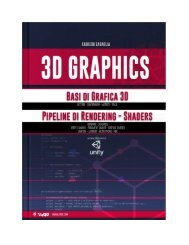Progettazione e Sviluppo di un Multiplayer Online Game su Reti Peer-to-Peer
Alma Mater Studiorum Universit`a degli Studi di Bologna Facolta` di Scienze Matematiche, Fisiche e Naturali Corso di Laurea in Scienze di Internet Tesi di Laurea in Laboratorio di Programmazione Internet
Alma Mater Studiorum Universit`a degli Studi di Bologna
Facolta` di Scienze Matematiche, Fisiche e Naturali
Corso di Laurea in Scienze di Internet
Tesi di Laurea in Laboratorio di Programmazione Internet
You also want an ePaper? Increase the reach of your titles
YUMPU automatically turns print PDFs into web optimized ePapers that Google loves.
118 CAPITOLO 6. CONCLUSIONI<br />
focus <strong>su</strong> quelli che sono gli aspetti relativi alla progettazione e allo sviluppo<br />
della parte prettamente Software.<br />
Il contes<strong>to</strong> analizza<strong>to</strong> è vas<strong>to</strong> e complesso e non è sta<strong>to</strong> possibile quin<strong>di</strong><br />
entrare nel dettaglio <strong>di</strong> ogni singolo aspet<strong>to</strong>: ad esempio le problematiche<br />
legate allo sviluppo <strong>di</strong> <strong>un</strong> Engine grafico o <strong>di</strong> <strong>un</strong> Engine fisico, grazie all’utilizzo<br />
<strong>di</strong> <strong>un</strong> Middleware come Unity3D, sono state affrontate solo in maniera<br />
marginale.<br />
Anche per quan<strong>to</strong> riguarda ciò che concerne maggiormente l’argomen<strong>to</strong><br />
<strong>di</strong> tesi alc<strong>un</strong>e caratteristiche che si possono in<strong>di</strong>viduare nella maggior parte<br />
dei giochi <strong>Multiplayer</strong> commerciali, come i sistemi <strong>di</strong> Anti-Cheating ed i Lobby<br />
Server, per questioni <strong>di</strong> tempo non sono state sviluppate concretamente<br />
all’interno del proget<strong>to</strong> (si veda il capi<strong>to</strong>lo 5 relativo agli sviluppi futuri).<br />
Ciò nonostante, la realizzazione <strong>di</strong> <strong>un</strong> videogioco <strong>Multiplayer</strong> basa<strong>to</strong> <strong>su</strong><br />
reti <strong>Peer</strong>-To-<strong>Peer</strong>, ha permesso <strong>di</strong> sperimentare con mano quelli che sono i<br />
problemi e le <strong>di</strong>fficoltà caratteristiche che emergono durante lo sviluppo <strong>di</strong><br />
<strong>un</strong> software videolu<strong>di</strong>co, ed in particolare nel caso in cui quest’ultimo ri<strong>su</strong>lti<br />
contestualizza<strong>to</strong> in <strong>un</strong>o scenario <strong>di</strong> rete decentralizza<strong>to</strong>:<br />
In <strong>un</strong>a prima fase sono state analizzate le tecnologie, gli strumenti e le<br />
architetture prevalentemente utilizzate nel panorama attuale, al fine <strong>di</strong> selezionare<br />
quelle più adatte all’obiettivo <strong>di</strong> tesi.<br />
Sono stati valutati quelli che sono i vantaggi e gli svantaggi del modello<br />
<strong>Peer</strong>-To-<strong>Peer</strong> in contrapposizione al modello Client-Server, e <strong>di</strong> conseguenza<br />
esaminati i sistemi <strong>di</strong> sincronizzazione utilizzati per mantenere <strong>un</strong>o sta<strong>to</strong> <strong>di</strong><br />
gioco con<strong>di</strong>viso da tutti i gioca<strong>to</strong>ri.<br />
Quest’ultimo aspet<strong>to</strong> rappresenta probabilmente il cuore del problema:





